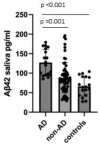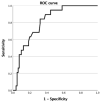Aβ42 as a Biomarker of Alzheimer's Disease: Is Saliva a Viable Alternative to Cerebrospinal Fluid?
- PMID: 36552188
- PMCID: PMC9775629
- DOI: 10.3390/brainsci12121729
Aβ42 as a Biomarker of Alzheimer's Disease: Is Saliva a Viable Alternative to Cerebrospinal Fluid?
Abstract
The identification of reliable biomarkers in biological fluids is paramount to optimizing the diagnosis of Alzheimer’s disease (AD). Measurement of Aβ42, t-tau, and p-tau in cerebrospinal fluid (CSF) is the most accepted method to support the diagnosis of AD. However, lumbar puncture represents an invasive investigation, whereas saliva is one of the most accessible body fluids. The aim of our study was to investigate salivary concentrations in AD and evaluate the correlation between salivary and CSF Aβ42 concentrations in AD patients, patients with non-AD dementias, and controls. We recruited 100 subjects: 18 AD patients, 64 patients with non-AD dementias, and 18 controls. The mean saliva Aβ42 concentrations in AD patients were higher than in controls (p < 0.001), and to patients with non-AD dementias (p = 0.001). A significant negative correlation between salivary and CSF Aβ42 concentrations was found in the overall group (r = −0.562, p < 0.001) and in non-AD patients (r = −0.443, p < 0.001). Salivary Aβ42 concentrations positively correlated with CSF t-tau (r = 0.321, p = 0.001) and p-tau (r = 0.297, p = 0.001). Our study showed that in AD patients’ saliva, Aβ42 concentrations are specifically increased, and we found an interesting negative correlation between CSF and salivary Aβ42 concentrations that warrants further investigation.
Keywords: Alzheimer’s disease; CSF; beta amyloid 42; biomarkers; saliva.
Conflict of interest statement
The authors declare no conflict of interest.
Figures





Similar articles
-
Association of PTHrP levels in CSF with Alzheimer's disease biomarkers.Clin Mass Spectrom. 2018 Oct 9;14 Pt B:124-129. doi: 10.1016/j.clinms.2018.10.001. eCollection 2019 Nov. Clin Mass Spectrom. 2018. PMID: 34917769 Free PMC article.
-
Cerebrospinal Fluid Alzheimer's Biomarkers and Neurofilament Light Profile of Idiopathic Normal Pressure Hydrocephalus in China: A PUMCH Cohort Study.Neurodegener Dis. 2020;20(5-6):165-172. doi: 10.1159/000514052. Epub 2021 Jun 2. Neurodegener Dis. 2020. PMID: 34077945
-
Cerebrospinal fluid biomarkers distinguish postmortem-confirmed Alzheimer's disease from other dementias and healthy controls in the OPTIMA cohort.J Alzheimers Dis. 2015;44(2):525-39. doi: 10.3233/JAD-141725. J Alzheimers Dis. 2015. PMID: 25391385
-
Fluid biomarker-based molecular phenotyping of Alzheimer's disease patients in research and clinical settings.Prog Mol Biol Transl Sci. 2019;168:3-23. doi: 10.1016/bs.pmbts.2019.07.006. Epub 2019 Jul 24. Prog Mol Biol Transl Sci. 2019. PMID: 31699324 Review.
-
Advantages and disadvantages of the use of the CSF Amyloid β (Aβ) 42/40 ratio in the diagnosis of Alzheimer's Disease.Alzheimers Res Ther. 2019 Apr 22;11(1):34. doi: 10.1186/s13195-019-0485-0. Alzheimers Res Ther. 2019. PMID: 31010420 Free PMC article. Review.
Cited by
-
Salivary Biomarkers for Alzheimer's Disease: A Systematic Review with Meta-Analysis.Int J Mol Sci. 2024 Jan 18;25(2):1168. doi: 10.3390/ijms25021168. Int J Mol Sci. 2024. PMID: 38256241 Free PMC article.
-
An Update of Salivary Biomarkers for the Diagnosis of Alzheimer's Disease.Int J Mol Sci. 2025 Feb 26;26(5):2059. doi: 10.3390/ijms26052059. Int J Mol Sci. 2025. PMID: 40076682 Free PMC article. Review.
-
Periodontitis-induced neuroinflammation triggers IFITM3-Aβ axis to cause alzheimer's disease-like pathology and cognitive decline.Alzheimers Res Ther. 2025 Jul 19;17(1):166. doi: 10.1186/s13195-025-01818-3. Alzheimers Res Ther. 2025. PMID: 40684176 Free PMC article.
-
Salivary biomarkers: The early diagnosis of Alzheimer's disease.Aging Med (Milton). 2024 Feb 20;7(2):202-213. doi: 10.1002/agm2.12282. eCollection 2024 Apr. Aging Med (Milton). 2024. PMID: 38725701 Free PMC article. Review.
-
Guidelines for the standardization of pre-analytical variables for salivary biomarker studies in Alzheimer's disease research: An updated review and consensus of the Salivary Biomarkers for Dementia Research Working Group.Alzheimers Dement. 2025 Feb;21(2):e14420. doi: 10.1002/alz.14420. Epub 2024 Dec 30. Alzheimers Dement. 2025. PMID: 39737743 Free PMC article. Review.
References
-
- Jack C.R., Jr., Bennett D.A., Blennow K., Carrillo M.C., Dunn B., Haeberlein S.B., Holtzman D.M., Jagust W., Jessen F., Karlawish J., et al. NIA-AA Research Framework: Toward a biological definition of Alzheimer’s disease. Alzheimer Dement. 2018;14:535–562. doi: 10.1016/j.jalz.2018.02.018. - DOI - PMC - PubMed

